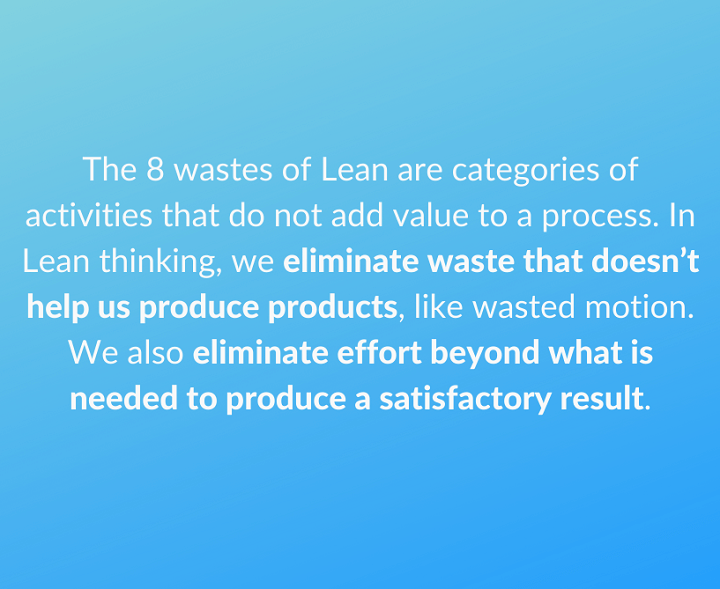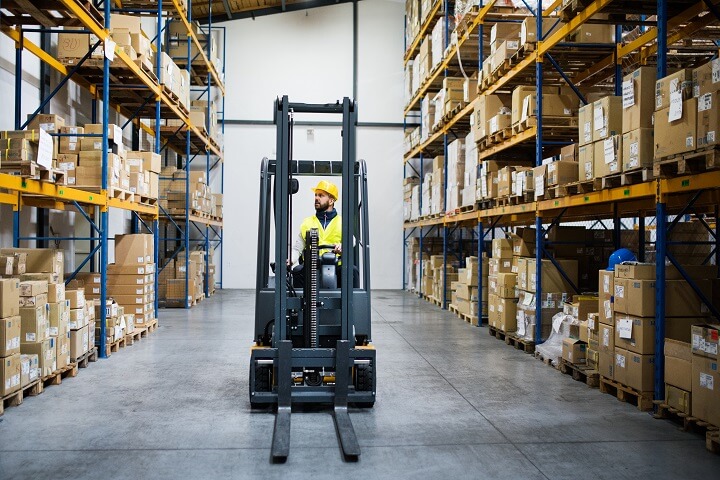The 8 wastes of Lean are categories of activities that do not add value to a process.
In Lean thinking, we eliminate waste that doesn’t help us produce products, like wasted motion. We also eliminate effort beyond what is needed to produce a satisfactory result. For example, production is good, but overproduction is wasteful.
The 8 wastes of Lean are:
These labels and their order make the letters for the 8 wastes DOWNTIME, which is a helpful mnemonic for remembering them.
Download your free 8 wastes template
Free template to help you plan the 8 wastes in your Lean Six Sigma projects

1. Defects
Products that don’t meet customer requirements have one or more defects. In Lean thinking, we reduce defects.
Products with defects might have to be sold at a lower price, be reworked before they can be given to the customer, or be thrown away. Worst of all, defects often lead to other waste. Defects often mean that you’ll spend resources correcting defects and learning about ways to improve your processes.
These costs make the costs of defects much higher than the cost of the defect times the number of defects.
8 wastes examples: Defects
- In a hospital, one defect is when patient medical records are not available at the time and place that they are needed.
- At a manufacturing plant, the most common defect for welding circuit boards is labeled “solder bridge.”
2. Overproduction
Overproduction means that you have too much. How do you distinguish between overproduction and inventory? We’ll usually use overproduction to discuss work-in-progress materials and inventory to describe when we have too many finished goods.

Sometimes, we’re tempted to overproduce on purpose, but the Lean idea is to produce what you need to deliver to the customer when the customer wants it.
8 wastes examples: Overproduction
- A convenience food manufacturer finds that poor forecasting of customer demand means that a lot of food with a short shelf life are discarded.
- A case study of a hospital kitchen shows reduction of overproduction when costly foods are prepared only when a customer orders them.
3. Waiting
Waiting occurs when people or equipment have to be idle instead of doing value-added activities. You’ll notice that different wastes relate to each other.
Tools like 5 Whys Root Cause Analysis can help you address the biggest problem. If you look at our first two wastes, you can see how defects might make someone wait while rework is done. You can see how overproduction might make someone wait while a part catches up with other production.
8 wastes examples: Waiting
- In the building industry, material shortages keep skilled workers waiting before they can proceed with value-added work.
- At a radiotherapy institute, the waiting time between a patient’s initial consultation and initial irradiation decreased by four days from a Lean implementation. This decrease means that care providers wait four days less, on average, to provide a value-added activity.

4. Non-utilized talent
Non-utilized talent is often made the 8th waste because it was not described as early as the other 7 wastes of Lean. Generally, non-utilized talent deals with not using the talent of people who provide services or produce goods.
Non-utilized talent can take many forms. This includes not involving people in process improvement efforts or having skilled workers do tasks that add less value than they are capable of. Non-utilized talent also applies to equipment.
8 wastes examples: Non-utilized talent
- In a hospital, MRI technicians sometimes have to register patients or serve as porters when there are not enough employees to perform those tasks.
- At a construction site, having a large earth mover that is too big for the job wastes the capability of the machine.
5. Transportation

A common general example relates transportation to overproduction. If you make too much of one part, you might have to carry it to storage and back.
Transportation can also lead to other wastes. For example, damage to products during transportation adds waste.
8 wastes examples: Transportation
- In a sewing department, the cost savings for reducing the distance that material moves by about 9 meters per unit are shown.
- A freight carrier identifies wasted miles in transit from the supplier to the customer.
6. Inventory
Excess inventory is sometimes hard to see as waste, but be cautious.
We’ve already seen some of the waste that can come with overproduction, which often leads to excess inventory. Remember, overproduction is about work-in-progress products and inventory is for finished goods.
Inventory waste often hides defect waste. If you have a lot of products, you can also have a lot of defects.
8 wastes examples: Inventory
- In a large construction project, ordering all the tiles for a project at once, instead of arranging for delivery when the tiles are needed, creates waste.
- In a hospital, excess inventory can include having more items for providing services than needed, making storage and maintenance more difficult.
7. Motion
While transportation usually means moving goods or parts, when people or equipment move, we’ll say motion. 5S maps, also called spaghetti diagrams, are popular tools for identifying motion waste.

8 wastes examples: Motion
- In a sewing department, arranging workers so that they face each other reduces the motion involved in passing work from one person to another.
- In a hospital where a doctor uses a computer during a patient consultation, putting the computer close to the patient reduces motion waste.
8. Extra processing
Extra processing is when steps, requirements, or features are added to a product that the customer doesn’t need.
An everyday example might be a stopwatch that measures to the hundredth of a second when the customer only keeps track of time to the second.
In manufacturing settings, tolerances that far exceed customer requirements often require expensive machinery or time-consuming work that is waste from the customer’s perspective.
8 wastes examples: Extra processing
- In a hospital, overprocessing can take the form of task duplication. For example, if a patient’s procedure has to be canceled because their medical records weren’t available (defect waste), then repeating the procedure preparation steps is overprocessing waste.
- In a warehouse, overprocessing occurs when all of the finished goods already in the transport area have to be moved before new goods can be brought in.
Ready for more?
Knowing what the 8 wastes of Lean are gets you ready to start eliminating them, but you can make greater strides with greater knowledge. GoSkills is the place for you to acquire the Lean knowledge and skills that can help your projects succeed.
Whether you're looking to become a Yellow Belt, Green Belt, or Black Belt with IASSC, GoSkills has the courses that you need. Start learning today!
Prepare to get certified in Lean Six Sigma
Start learning today with GoSkills courses
Start free trial



